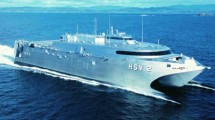Abstract
The slamming behaviour of a large high-speed catamaran has been investigated through the analysis of full-scale trials data. The US Navy conducted the trials in the North Sea and North Atlantic region on a 98 m wave piercer catamaran, HSV-2 Swift, designed by Revolution Design Pty Ltd and built by Incat Tasmania. For varying wave headings, vessel speeds and sea states the data records were interrogated to identify slam events. An automatic slam identification algorithm was developed, considering the measured rate of change of stress in the ship’s structure coupled with the vessel’s pitch motion. This has allowed the slam occurrence rates to be found for a range of conditions and the influence of vessel speed, wave environment and heading to be determined. The slam events have been further characterised by assessing the relative vertical velocity at impact between the vessel and the wave. Since the ship was equipped with a ride control system, its influence on the slam occurrence rates has also been assessed.

















Similar content being viewed by others
References
Blunden A (ed) (1990–2011) Fast ferry international. Fast Ferry Information Ltd, London, UK
Rothe F, Sames P, Schellin T (2001) Catamaran wetdeck structural response to wave impact. In: Proceedings of the 6th international conference on fast sea transportation (FAST2001) 3. Southampton, UK, pp 125–133
Thomas G, Davis MR, Holloway DS, Roberts T (2003) Transient slam response of large high speed catamarans. In: Proceedings of the 7th international conference on fast sea transportation (FAST2003) 2. Ischia, Italy, pp B1.1–B1.8
Thomas G, Davis MR, Holloway DS, Roberts T (2008) The vibratory damping of large high-speed catamarans. Marine Struct 21(1):1–21
Thomas G, Davis MR, Holloway D, Roberts T (2006) The influence of slamming and whipping on the fatigue life of a high-speed catamaran. Aust J Mech Eng 3(2):165–174
Steinmann P, Fach K, Menon B (1999) Global and slamming sea loads acting on an 86 m high speed catamaran ferry. In: Proceedings of the 5th international conference on fast sea transportation (FAST1999). Seattle, USA, pp 709–718
Roberts T, Watson N, Davis MR (1997) Evaluation of sea loads in high speed catamarans. In: Proceedings of the 5th international conference on fast sea transportation (FAST1997). Sydney, Australia, pp 311–316
Thomas G, Davis MR, Holloway DS, Watson N, Roberts T (2003) Slamming response of a large high-speed wave-piercer catamaran. SNAME Marine Tech J 40(2):126–140
Amin W, Davis MR, Thomas G, Holloway DS (2009) Slamming quasi-static analysis of an incat 98-m high-speed wave piercing catamaran. In: Proceedings of the international conference for innovation in high speed marine vehicles, Fremantle, Australia
Fu TC, Fullerton AM, Terrill E, Faller W, Lada G, Hess D, Minnick L (2009) Measurement and modeling of the motions of a high-speed catamaran in waves. In: Proceedings of the 28th international conference on ocean, offshore and arctic engineering (OMAE2009), Honolulu, Hawaii, USA
Brady TF, Bachman RJ, Donnelly MJ, Griggs DB (2004) HSV-2 Swift instrumentation and technical trials plan. Technical Report, Naval Surface Warfare Center Carderock Division
Davis MR, Watson N, Holloway DS (2005) Measurements of response amplitude operators for an 86 m high-speed catamaran. J Ship Res 49(2):121–143
Dessi D, Ciappi E (2013) Slamming clustering on fast ships: from impact dynamics to global response analysis. Ocean Eng 62:110–122
Welch PD (1967) The use of fast fourier transform for the estimation of power spectra: a method based on time averaging over short, modified periodograms. IEEE Trans Audio Electroacoust 15:70–73
Thomas G (2003) Wave slam response of large high speed catamarans. PhD Thesis, University of Tasmania
Jacobi G, Thomas G, Davis MR, Holloway DS, Davidson G, Roberts T (2012) Full-scale motions of a large high speed catamaran: the influence of wave environment, speed and ride control system. Int J Maritime Eng (RINA Trans Part A) 154(A3):143–155
Thomas G, Winkler S, Davis M, Holloway D, Matsubara S, Lavroff J, French B (2011) Slam events of high-speed catamarans in irregular waves. J Mar Sci Technol 16(1):8–21
Ochi MK, Motter LE (1973) Prediction of slamming characteristics and hull responses for ship design. Trans SNAME 81:144–176
Acknowledgments
The authors acknowledge the work of Naval Surface Warfare Center, Carderock Division, USA in conducting the full-scale measurements, and thank them for making the data available for analysis.
Author information
Authors and Affiliations
Corresponding author
Additional information
G. Jacobi is a visiting researcher from University of Rostock, Germany.
About this article
Cite this article
Jacobi, G., Thomas, G., Davis, M.R. et al. An insight into the slamming behaviour of large high-speed catamarans through full-scale measurements. J Mar Sci Technol 19, 15–32 (2014). https://doi.org/10.1007/s00773-013-0229-y
Received:
Accepted:
Published:
Issue Date:
DOI: https://doi.org/10.1007/s00773-013-0229-y




